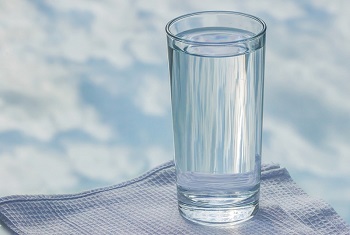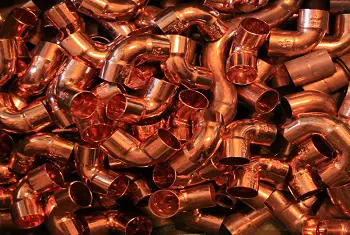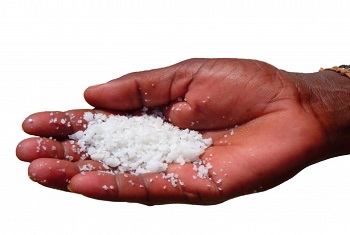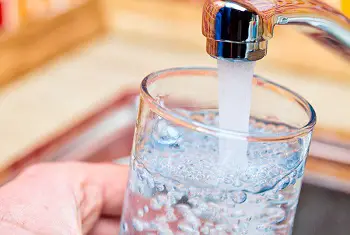When it comes to what reverse osmosis water and what you can expect it to taste like, I think that it is best to understand what it won’t taste like. Since reverse osmosis is the removal of unwanted contaminants from your water, it will lack the unwanted salty or metallic tastes that you might experience with your untreated water.
Reverse osmosis water has a very clean taste to it because the process of reverse osmosis has removed most of the sodium from the water that causes it to taste salty, magnesium that will give water a bitter taste, and calcium which gives water a milky taste.
Because the majority of the dissolved solids, chemicals, and impurities have been removed from reverse osmosis water, it will have very little taste. But there are factors that can give reverse osmosis water unexpected tastes that some people find unpleasant.
Does reverse osmosis water have any taste?

Reverse osmosis water will have considerable less taste than untreated water. But even the best reverse osmosis drinking water systems will not necessarily remove everything in the water that can give it some kind of taste.
Reverse osmosis drinking water systems will also remove most odors that may have been in the untreated water. Because our sense of smell greatly contributes to how we perceive taste and flavors in the things that we eat, the lack of odor in the water can make the water seem to taste even cleaner.
Check out this quick video about how reverse osmosis removes impurities from your water that can affect the taste of your water.
The only reason that water has any flavor at all is because of the impurities that are contained in it. Different impurities and combinations of impurities are why we find that water will taste different from one area to another.
If water has a significantly higher level of sodium that it does iron, we will consider it to be salty even though there may be a significant amount of iron in the water.
Sulfur-rich water will have a rotten egg smell to it which makes most people forget the taste of the water because the smell is more prominent.
Have you ever been outside on a clear summer day and a big smokey truck drives by and the exhaust fumes make you cough? Then after a few moments, the air clears and you get a breath of fresh clean air?
Well, that’s a bit like drinking water before it goes through the process of reverse osmosis and then drinking it after reverse osmosis. In the air, the smoke particles go away and the air smells fresh. In water, the minerals are removed, and the water tastes pure.
Why wouldn’t I want some taste in my water?
If you are a regular water drinker and drink several glasses per day then, of course, you would want to drink water that tastes good, but you also want to drink water that is good for you.
By using a reverse osmosis drinking water system, you will be able to remove minerals and extra sodium that you do NOT want and then add minerals or flavors that you do want and are beneficial to your health and taste good.
Coffee and tea drinkers love reverse osmosis water because it allows the true flavor of the coffee or tea to come through without the salty or bitter tastes that can be in untreated water.
But many coffee drinkers believe that there should be dissolved minerals in the water to help blend the flavors of the coffee. This seems to be a personal preference, you should enjoy your coffee whichever way you choose.
Can cooking with reverse osmosis water affect the taste of my food?
It is perfectly fine to cook with reverse osmosis water, and some chefs actually recommend using reverse osmosis water for everything that you cook or bake. This all really depends on what kind of water we are using in the first place.
Some water comes straight out of the ground with no hard minerals or iron in it, and even with very little dissolved solids like sodium in it.
Although this is not common, some water that is untreated by any artificial means may be better for cooking than water that has been filtered by reverse osmosis.
It boils down to what is in your untreated water, and do you want it to get into your food when you cook it.
I usually recommend using reverse osmosis water for foods that contain a high amount of water or will absorb a large amount of water when they are cooked.

Soups, stews, and gravies all contain a lot of water and you probably want your soup to taste like the ingredients that you put into it and not salty from the water that you added to it.
This is where using reverse osmosis will be the most beneficial in cooking.
Rinsing vegetables, meats or other foods that require rinsing off before cooking will not absorb much if any of the water used to rinse them so using regular tap water is often just fine.
Pasta, dried herbs or other foods that will absorb a lot of liquid when cooking should be cooked in reverse osmosis water to preserve there intended taste.
Not all reverse osmosis water will taste the same.
Although using a reverse osmosis drinking water system is highly recommended, it does not mean that your water will taste totally pure.
It will take out a very high amount of what adds taste to water, but water from different sources will have different minerals, and therefore different tastes.
Why does my reverse osmosis water taste bad?
Reverse osmosis drinking water systems are great at removing unwanted contaminants in water that can give an unpleasant taste, but even reverse osmosis won’t always remove everything in the water that can make it taste bad.
Fluctuations in your water table can affect the levels of minerals in your water which can change the taste of your untreated drinking water which will affect the taste of your reverse osmosis water as well.
Some common bad tastes in reverse osmosis water.
Metallic taste:

Mostly due to the corrosion of copper tubing used in your reverse osmosis system or copper piping used in your home.
Because the process of reverse osmosis removes minerals that neutralize acid in your water, reverse osmosis water is almost always acidic.
Acidic water can corrode metal pipes and tubing which means that particles from the pipes or tubing can end up in the water that you drink. Metal particles in your drinking water will mean a metallic taste when drinking your water.
A metallic taste in your reverse osmosis water can also be due to a high concentration of dissolved solids in the water such as sulfates, chlorides, and bicarbonates.
We all know that road salt used to remove ice from our roads can corrode the metal of our vehicles. Well, high levels of sodium and other dissolved solids in your reverse osmosis water can cause corrosion of metal tubing used in your drinking water system.
Salty taste:

Often the result of uncommonly high amounts of salt in the water entering the reverse osmosis system.
Heavy salting of roads in winter can lead to salt contamination in wells to the point where even reverse osmosis will not remove enough of the sodium to leave the water tasting pure.
This could also mean that your reverse osmosis system is no longer filtering out contaminants. Your reverse osmosis membrane may need to be replaced or other problems with the system itself.
Sour taste:

A sour taste can be caused by a high level of carbon dioxide in the water which often causes a decrease in the pH of the water.
Also, some prescription medications have been known to react with reverse osmosis water and leave a bitter taste.
Reverse osmosis water tastes like regular tap water:

Most likely your reverse osmosis system membrane is no longer filtering out contaminants as it should and needs to be replaced.
A reverse osmosis membrane is basically a fine mesh filter that has tiny openings in it to allow water to pass through but reject impurities.
Over time, these openings can become larger due to chemical corrosion and normal wear. When these openings become larger, they will no longer reject all of the impurities that the membrane was intended to remove.
This means that the water coming out of the reverse osmosis membrane will taste more and more like the tap water going into the membrane. Eventually, your reverse osmosis drinking water will taste virtually the same as the water coming from your regular faucet.
Why does my neighbors reverse osmosis water taste better than mine?
Even water from the exact same water source can taste very different from one home to another. If you are using private wells, they may be of different depths and therefore produce different water characteristics.
One house being just a bit higher up a hill may have a different combination of minerals and impurities in the water than a house lower down the hill.
Although all reverse osmosis drinking water systems use a semi-permeable membrane to remove unwanted contaminants from water, all membranes are not the same and all reverse osmosis drinking water systems are not created equal.
A reverse osmosis membrane is a tightly rolled, semi-permeable membrane material that is wound to a specific size depending on what type of reverse osmosis system that it is going to be used for.
Although most reverse osmosis drinking water systems look very much the same, the reverse osmosis membrane in them can be very different.
Two membranes that are designed to be used for the exact same reverse osmosis system can yield different quality water.
A reverse osmosis membrane becomes less effective at filtering water over time. The semi-permeable membrane will break down and allow more contaminants to get through the older the membrane gets.
If one home has a reverse osmosis system with a membrane that is brand new, and a second home has a reverse osmosis system with a membrane that is 5 years old, the taste of the filtered water may very well taste different.
Can old filters make reverse osmosis water taste bad?
How long it has been since the filters have been changed can affect the taste of reverse osmosis water.
If the reverse osmosis system’s pre-filter has not been changed in a while, it may not be allowing strong enough pressure to get through.
A reverse osmosis membrane works best when water is being forced through it, if the water is having a hard time getting to the membrane, the product water may not be filtered as well as it should.
So to put it simply, when it comes to how reverse osmosis water tastes, it depends greatly upon the water going into the reverse osmosis system, the type of filtration that the reverse osmosis system offers, and the condition of the system.
To Sum Up:
Not all reverse osmosis systems are designed to work the same. Water coming from a private well may need a different reverse osmosis system than water coming from a municipal water supply.
Choosing the best reverse osmosis system for your needs is not complicated, you just need a highly recommended reverse osmosis system that will provide the best quality water for your situation.




What type of reverse osmosis filter would I need for my water which is coming from a well
Through a water softener and iron remover regards Gerry.
Hello Gerard and thank you for the question.
Any quality reverse osmosis drinking water system will work well with water that has been through a water softener and iron removal system.
It is very important that the water going into a reverse osmosis system is soft and free of iron as hard minerals or iron will damage a reverse osmosis membrane over time.
A reverse osmosis system is primarily used to remove dissolved solids (like sodium) from your water. If the amount of Total Dissolved Solids (TDS) in your water is relatively low, you may not need a reverse osmosis system at all.
Many brands of bottled water have a TDS of as high as 60-70 which is still quite low. You should test the TDS of your water first.
A reverse osmosis drinking water system will reduce the TDS by up to 98% in most cases. So if your tap water has a TDS of 400, the water coming out of the reverse osmosis drinking water system may be as low as about 8.
There may be other impurities in your water that a reverse osmosis system would help with but you would need a more complete water test to determine what is in your tap water.
You could contact a local laboratory or use a DIY Water Test Kit to get results yourself.
Check out my Recommended Reverse Osmosis Drinking Water Systems for some popular systems.
I hope this was helpful!
Paul
Thanks for useful info. I put a bag of swimming pool salt accidentally into the ion exchanging softener. Followed your advice–removed most and will put another softener salt (sodium chloride) when it goes down a little further.
You’re welcome Ralph, glad I could help!
Paul
Hi, great info. A newly installed commercial water store has opened up near me. Water softener, 10 and 5 micron pre and post filters, and RO membrane similar to most stores. The RO water coming out has a TDS of 3-7 typically and PH 6.5-7. The water taste is good, but leaves a fuzzy tongue, almost like a film in my mouth. They show recent lab tests that everything is good, but I don’t get the same fuzzy tongue from another local store with similar equipment. I’d like to get something for my house but am a little apprehensive to get that fuzzy tongue feeling.
Hello Paul and thank you for the question.
The Fuzzy feeling that you are getting on your tongue might simply be tiny bubbles dissolved in the water that are coming out of the water when they are on your tongue.
Air can be dissolved in water and kept dissolved while in a reverse osmosis drinking water system because the water is under pressure, then when the water is dispensed from the system, the bubbles come out of the water similar to when you open up a fresh bottle of soda.
This fuzzy feeling from the water in the store may not occur when the system is used elsewhere.
I hope this was helpful.
Paul